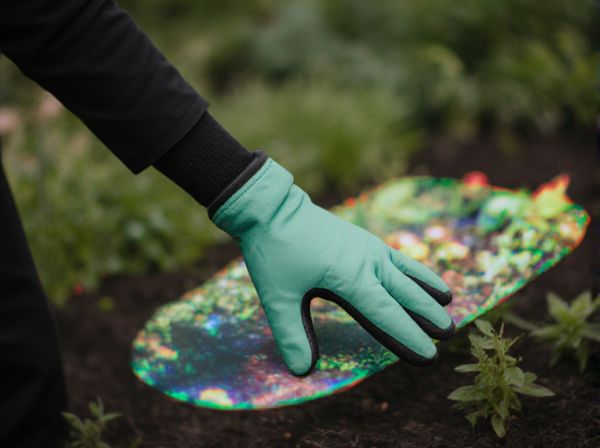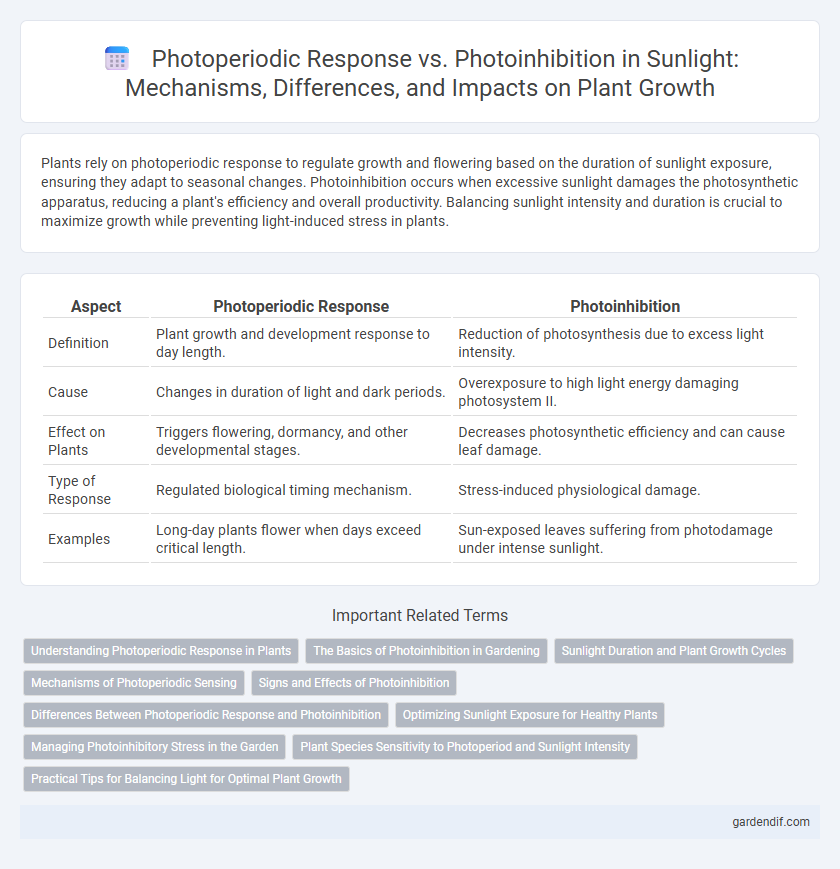
Photoperiodic response vs photoinhibition Illustration
Plants rely on photoperiodic response to regulate growth and flowering based on the duration of sunlight exposure, ensuring they adapt to seasonal changes. Photoinhibition occurs when excessive sunlight damages the photosynthetic apparatus, reducing a plant's efficiency and overall productivity. Balancing sunlight intensity and duration is crucial to maximize growth while preventing light-induced stress in plants.
Table of Comparison
| Aspect | Photoperiodic Response | Photoinhibition |
|---|---|---|
| Definition | Plant growth and development response to day length. | Reduction of photosynthesis due to excess light intensity. |
| Cause | Changes in duration of light and dark periods. | Overexposure to high light energy damaging photosystem II. |
| Effect on Plants | Triggers flowering, dormancy, and other developmental stages. | Decreases photosynthetic efficiency and can cause leaf damage. |
| Type of Response | Regulated biological timing mechanism. | Stress-induced physiological damage. |
| Examples | Long-day plants flower when days exceed critical length. | Sun-exposed leaves suffering from photodamage under intense sunlight. |
Understanding Photoperiodic Response in Plants
Photoperiodic response in plants is the physiological reaction to the length of day and night, crucial for regulating flowering and growth cycles according to seasonal changes. This response involves the detection of light duration by photoreceptors such as phytochromes and cryptochromes, which modulate gene expression controlling developmental processes. Unlike photoinhibition, which is light-induced damage to the photosynthetic apparatus under excessive sunlight, photoperiodic response optimizes plant growth and reproduction by adapting to varying daylight periods.
The Basics of Photoinhibition in Gardening
Photoinhibition occurs when excessive sunlight damages the photosynthetic machinery, particularly photosystem II, reducing a plant's ability to convert light energy into chemical energy. In gardening, managing light exposure is crucial to prevent photoinhibition, which can stunt growth and decrease crop yields by causing oxidative stress and chlorophyll degradation. While photoperiodic response regulates plant developmental stages based on day length, photoinhibition is an immediate reaction to light intensity that impacts photosynthetic efficiency and overall plant health.
Sunlight Duration and Plant Growth Cycles
Sunlight duration critically influences plant growth cycles by regulating photoperiodic responses, which determine flowering and developmental stages based on day length. Prolonged exposure to sunlight optimizes photosynthesis, but excessive light intensity can trigger photoinhibition, reducing photosynthetic efficiency and stunting growth. Balancing sunlight duration ensures optimal plant productivity by aligning photoperiodic signaling with light-induced stress thresholds.
Mechanisms of Photoperiodic Sensing
Photoperiodic sensing relies on phytochromes and cryptochromes to detect changes in day length, which regulate plant developmental processes such as flowering and dormancy. These photoreceptors modulate gene expression by interacting with circadian clock components, enabling plants to measure night duration precisely. Photoinhibition, in contrast, involves excessive light intensity damaging photosystem II, but it does not directly influence the molecular mechanisms governing photoperiodic responses.
Signs and Effects of Photoinhibition
Photoinhibition occurs when excessive sunlight damages the photosynthetic apparatus, primarily Photosystem II, leading to reduced photosynthetic efficiency and decreased plant growth. Signs of photoinhibition include chlorosis, leaf necrosis, and impaired chlorophyll fluorescence, indicating a disruption in the light-dependent reactions. The effects involve reduced carbon fixation, lowered biomass production, and an overall decline in plant productivity under high light stress conditions.
Differences Between Photoperiodic Response and Photoinhibition
Photoperiodic response regulates plant developmental processes based on day length, affecting flowering and growth cycles through photoreceptor activation, while photoinhibition occurs when excessive sunlight damages the photosynthetic apparatus, reducing photosynthetic efficiency. Photoperiodic response involves gene expression changes triggered by specific light durations, whereas photoinhibition results from overexcitation of photosystem II leading to reactive oxygen species formation. These mechanisms differ fundamentally in function: photoperiodic response optimizes plant adaptation to seasonal light variations, and photoinhibition protects against light-induced cellular damage.
Optimizing Sunlight Exposure for Healthy Plants
Balancing photoperiodic response and photoinhibition is essential for optimizing sunlight exposure to promote healthy plant growth. Photoperiodic response regulates critical processes like flowering and dormancy based on day length, while photoinhibition occurs when excessive sunlight damages the photosynthetic machinery. Managing light intensity and duration ensures maximal photosynthetic efficiency and prevents stress, supporting robust plant development and productivity.
Managing Photoinhibitory Stress in the Garden
Photoinhibitory stress occurs when excessive sunlight damages the photosynthetic apparatus, reducing plant growth and productivity. Managing photoinhibitory stress involves strategies like providing shade, optimizing watering schedules, and selecting plant varieties with higher tolerance to intense light. Understanding the balance between photoperiodic response and photoinhibition enables gardeners to enhance plant resilience and maintain optimal photosynthesis under variable sunlight conditions.
Plant Species Sensitivity to Photoperiod and Sunlight Intensity
Plant species exhibit varied sensitivity to photoperiod, with some requiring specific day lengths to trigger flowering or growth, while others remain unaffected. Photoinhibition occurs when sunlight intensity exceeds a plant's photosynthetic capacity, causing damage to the photosystem II and reducing overall photosynthetic efficiency. Understanding the balance between photoperiodic response and photoinhibition is crucial for optimizing plant growth in environments with fluctuating sunlight intensity.
Practical Tips for Balancing Light for Optimal Plant Growth
Photoperiodic response regulates plant growth cycles based on light duration, while photoinhibition occurs when excessive sunlight damages photosynthetic apparatus. To optimize plant growth, provide balanced light exposure by using shade cloths or adjustable grow lights to prevent photoinhibition while ensuring sufficient photoperiods for flowering and fruiting. Monitoring light intensity with a PAR meter helps maintain ideal photosynthetically active radiation, promoting healthy development without stress.
Photoperiodic response vs photoinhibition Infographic

 gardendif.com
gardendif.com